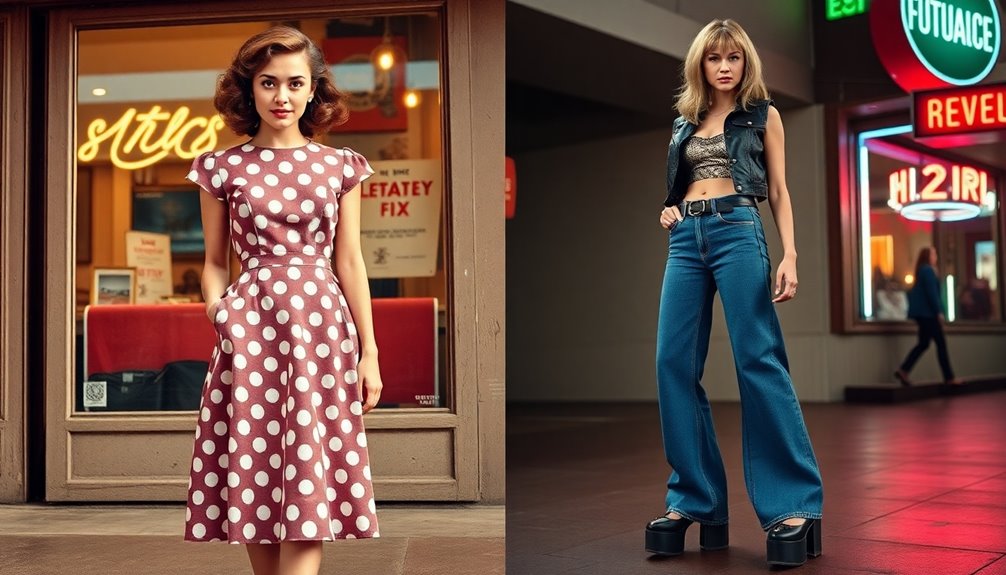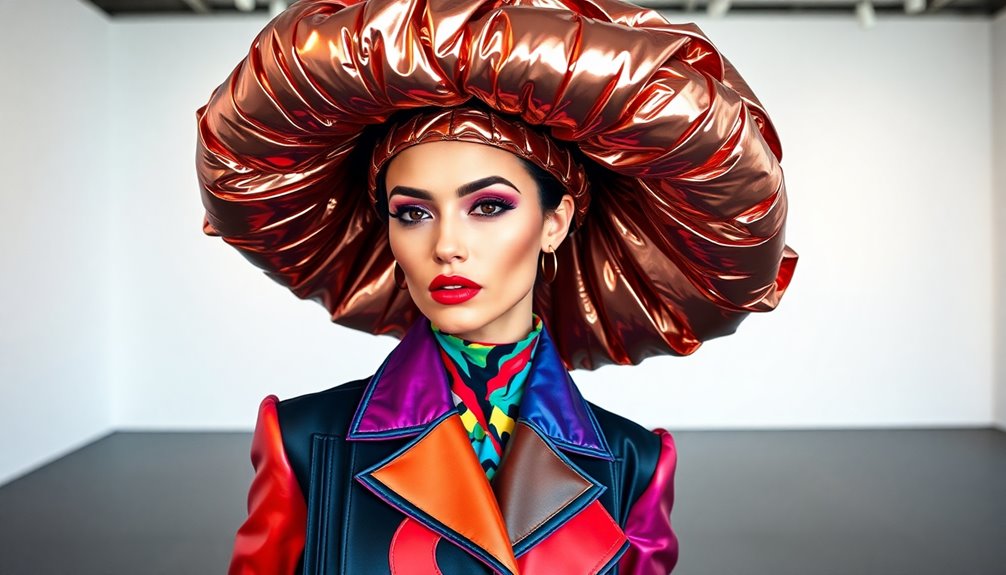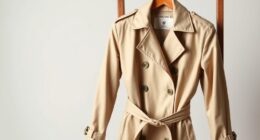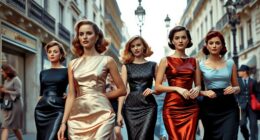From the glamorous silhouettes of the 1950s to the playful Y2K trends, fashion's journey reflects cultural shifts and societal values. You'll see the rise of nipped-in waists and full skirts in the '50s, the bold Mod styles of the '60s, and disco-inspired outfits in the '70s. The '80s brought power dressing and excess, while the '90s introduced grunge and minimalist aesthetics. Now, Y2K styles are making a comeback, fueled by social media. Each decade tells a story, showcasing how trends evolve. Keep exploring to uncover the fascinating connections between these iconic styles!
Key Takeaways
- The 1950s introduced the New Look with feminine silhouettes and accessories, marking a shift towards sophisticated eveningwear and youthful casual styles.
- The 1960s embraced the Mod style, featuring bold patterns and the miniskirt, symbolizing women's liberation and new fashion attitudes.
- The 1970s celebrated bohemian and disco fashion, characterized by flowy fabrics, vibrant colors, and iconic figures like David Bowie influencing trends.
- The 1980s focused on power dressing with bold silhouettes, oversized blazers, and logo-centric luxury brands reflecting corporate culture and excess.
- Y2K trends revitalize nostalgic styles through social media, with an increasing interest in vintage and sustainable fashion reflecting modern consumer values.
The 1950s: Glamour and Femininity
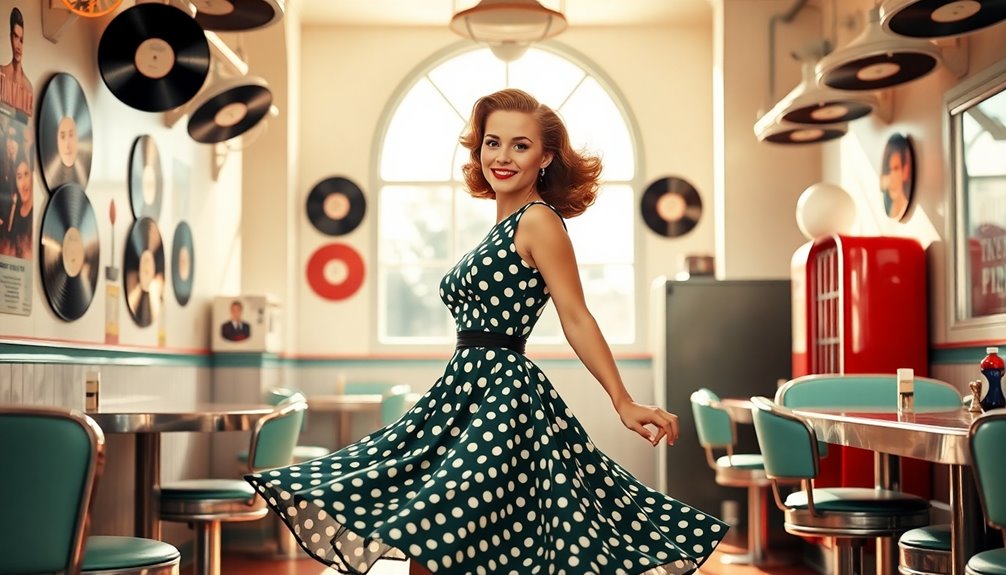
As the 1950s unfolded, you could see a remarkable shift in fashion that celebrated glamour and femininity, largely driven by the iconic New Look from Christian Dior.
This style, with its nipped-in waists and full skirts, marked a return to elegance after WWII. Cocktail dresses and eveningwear became staples, showcasing strapless bodices and intricate designs that exuded sophistication for formal occasions.
Meanwhile, casual styles like sundresses and poodle skirts emerged, allowing everyday wear to embrace a playful spirit. Accessories such as wide-brimmed hats, gloves, and statement jewelry reflected the era's optimism and desire for glamour.
The influence of youth culture also introduced jeans and leather jackets for young men, creating a contrast that defined the decade's fashion landscape. Additionally, this era's emphasis on cognitive function through dietary choices, like the rise of coffee consumption, mirrored the vibrant lifestyle embraced by many women of the time.
The 1960s: Revolution and Mod Styles
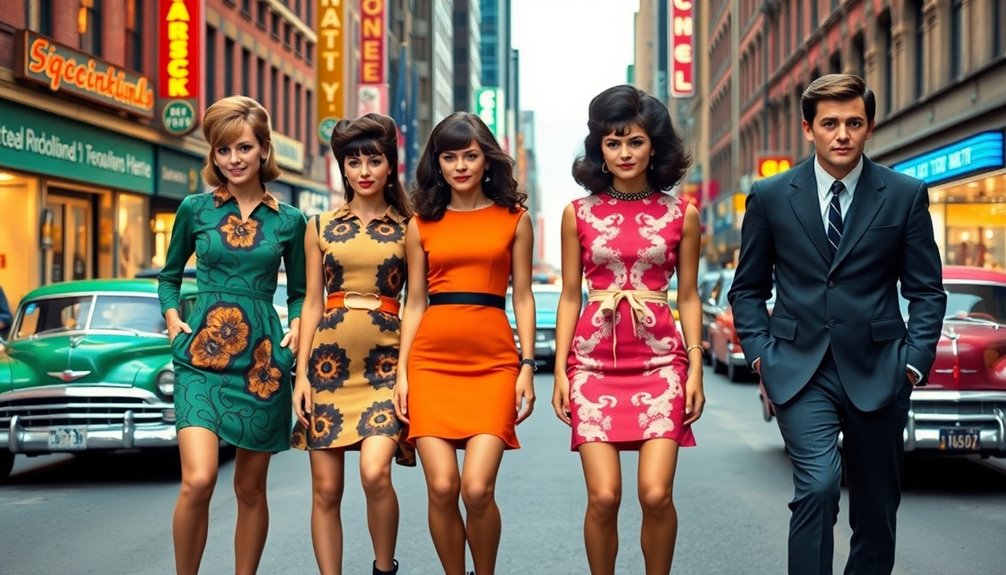
The 1960s burst onto the fashion scene as a decade of vibrant change and bold expression, driven by a cultural revolution that transformed societal norms.
You'll notice that the Mod style took center stage, showcasing eye-catching geometric patterns and vivid colors, popularized by icons like Twiggy and The Beatles.
Miniskirts, designed by Mary Quant, emerged as a powerful symbol of women's liberation, reflecting new attitudes toward femininity and sexuality.
Innovations in synthetic materials introduced playful prints and styles, while accessories like knee-high boots and oversized sunglasses completed the look.
The influence of counterculture also brought bohemian styles into the mix, emphasizing relaxed and expressive fashion choices.
- Bold geometric patterns
- Iconic miniskirts
- Synthetic materials
- Statement accessories
The 1970s: Bohemian and Disco Trends
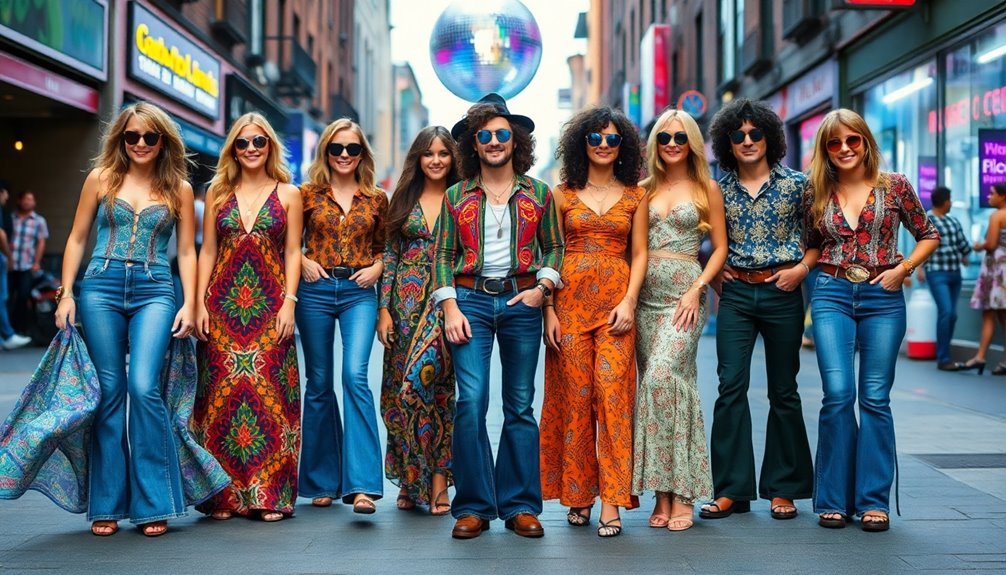
Emerging from the vibrant upheaval of the 1960s, the 1970s embraced a rich tapestry of style that celebrated both individuality and exuberance.
You'd find bohemian fashion flourishing, with flowy fabrics, ethnic prints, and vintage-inspired silhouettes reflecting a spirit of freedom. At the same time, disco culture exploded onto the scene, introducing vibrant colors, shiny fabrics, and form-fitting outfits like jumpsuits and sequined dresses that lit up dance floors.
Designers like Halston defined the era with minimalist styles, while accessories like oversized sunglasses and statement jewelry perfectly complemented both bohemian and disco looks.
Icons such as David Bowie and Donna Summer not only shaped music but also left an indelible mark on the fashion landscape, creating a visual language synonymous with the 1970s.
The 1980s: Power Dressing and Excess
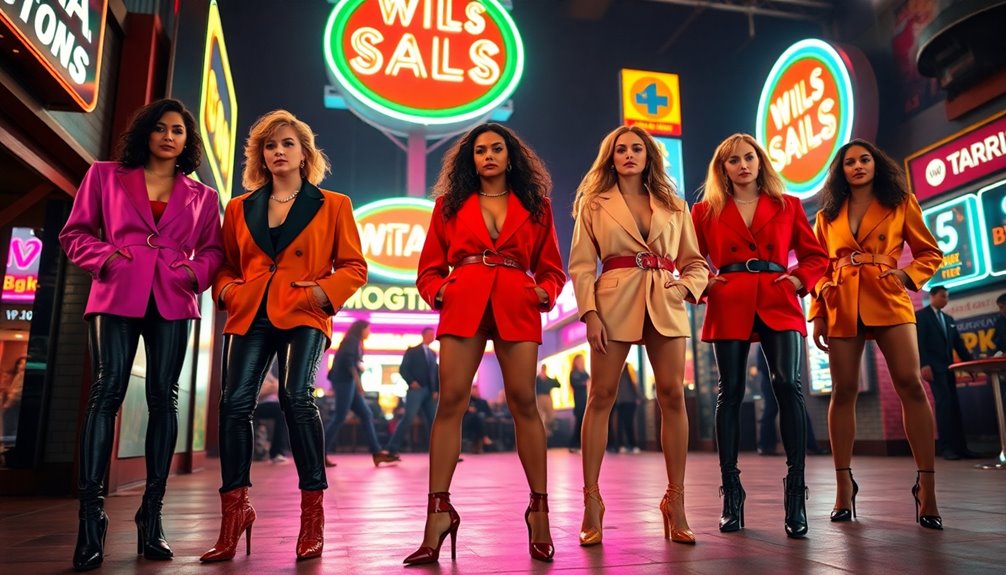
With the corporate world evolving and women's roles expanding, the 1980s ushered in a bold era of power dressing that transformed the fashion landscape.
You'd see bold silhouettes and shoulder pads dominating the scene, as designers like Yves Saint Laurent and Gianni Versace championed the "dress for success" mantra. Luxury brands became status symbols, with logo-centric fashion epitomized by Louis Vuitton monogram bags.
- Oversized blazers and high-waisted trousers reflected excess
- Flamboyant patterns drew inspiration from pop culture icons like Madonna
- Music videos on MTV propelled trends like leg warmers and acid-wash denim
- A blend of athletic and street styles defined everyday fashion
This decade boldly celebrated individuality and ambition through fashion.
The 1990s: Grunge and Minimalism
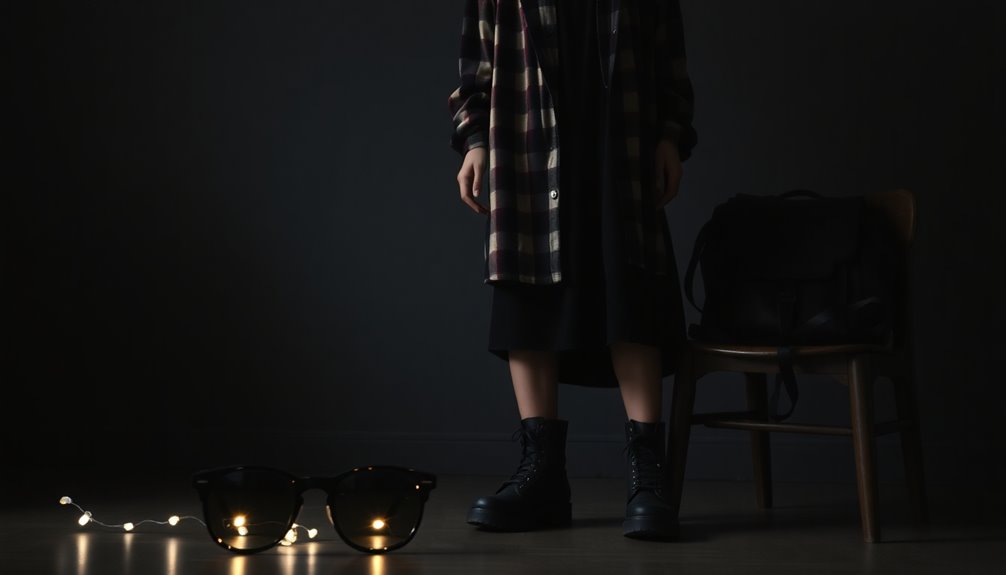
In the 1990s, you saw a major shift in fashion with the rise of grunge and minimalism.
Bands like Nirvana inspired a rebellious look that featured flannel shirts and ripped jeans, while designers like Calvin Klein pushed for clean lines and subtle elegance.
This decade brought a unique blend of edgy and understated styles that still influences fashion today.
Grunge Aesthetic Revolution
As the early 1990s unfolded, the grunge aesthetic took the fashion world by storm, challenging the polished norms of the previous decade. This revolution was marked by a raw, anti-establishment attitude that resonated with youth culture.
You saw oversized silhouettes, thrifted finds, and a distinctive blend of punk influences that defined 90s fashion. Style icons like Courtney Love and Kate Moss embodied this look, influencing trends with their unique vibes.
- Flannel shirts
- Ripped jeans
- Combat boots
- Layered clothing
Designers like Marc Jacobs and Anna Sui brought grunge elements to high fashion, solidifying its place in contemporary style. The grunge aesthetic not only transformed wardrobes but also represented a powerful counterculture movement that celebrated individuality, much like the way vibrational alignment influences personal expression and creativity in various aspects of life.
Minimalist Fashion Principles
While the grunge aesthetic grabbed headlines in the early 90s, minimalist fashion quietly carved out its own significant space in the industry.
You'll find that minimalist fashion is all about clean lines and neutral color palettes, focusing on simplicity and functionality. Designers like Calvin Klein and Jil Sander championed understated silhouettes and high-quality fabrics, creating looks that exude elegance without excess.
The little black dress became a staple, showcasing its versatility and timeless appeal amidst the decade's trends.
Fashion media played an essential role in popularizing these designs, presenting them as a sophisticated alternative to the more elaborate styles of the past.
In the 90s fashion landscape, minimalism offered an invigorating take on style that continues to resonate today. This emphasis on simplicity can also be likened to the concept of establishing healthy boundaries, promoting a sense of clarity and respect in personal expression.
The Rise of Y2K Aesthetic

The Y2K aesthetic has surged into the spotlight, enchanting fashion enthusiasts with its vibrant colors, metallic fabrics, and nostalgic nods to the early 2000s. This trend, driven by social media platforms like TikTok and Instagram, captures the essence of an era that resonates with Gen Z.
Key fashion items defining the Y2K aesthetic include:
- Low-rise jeans
- Juicy Couture tracksuits
- Chunky footwear
- Logoed accessories
Fast-fashion retailers like ASOS and Shein have embraced these trends, reintroducing iconic pieces to meet demand.
However, it's vital to recognize the contributions of Black women in shaping these trends and to engage in discussions about cultural appropriation within the Y2K aesthetic.
Cultural Influences on Y2K Fashion
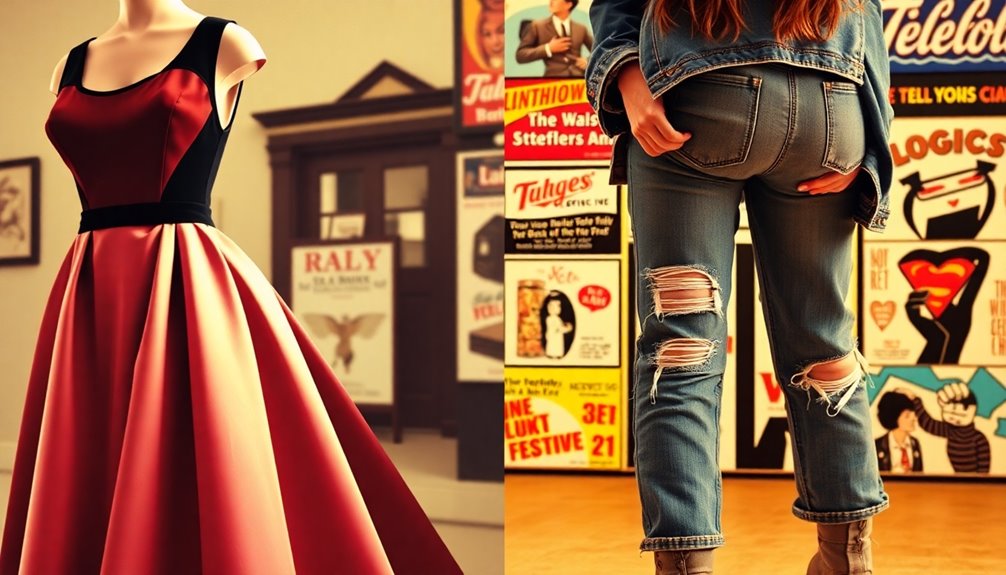
Y2K fashion isn't just a revival of styles; it's a reflection of the cultural landscape that shaped them. The resurgence of interest in this trend draws heavily from early 2000s digital culture, particularly through platforms like Tumblr that sparked nostalgia.
Iconic figures such as Paris Hilton and Bratz dolls became emblematic of the era, influencing contemporary influences that blend the old with the new. K-pop groups like New Jeans have embraced Y2K aesthetics, incorporating low-rise pants and vibrant colors, appealing to both older and younger audiences.
Cultural events, including Britney Spears' memoir and Mattel's Barbie rebranding, have also helped reshape perceptions, fostering a playful embrace of Y2K fashion's experimental spirit.
Fast Fashion's Impact on Trends

Fast fashion exploded in the early 2000s, giving you access to trendy styles at unbeatable prices.
However, this rapid production raised ethical questions around labor practices and environmental impact, as many consumers began to notice the costs behind their clothing choices.
As you navigate this landscape, you'll see how these factors are reshaping your shopping habits and sparking a renewed interest in sustainability.
Rise of Fast Fashion
As fashion trends evolved rapidly in the early 2000s, consumers found themselves drawn to affordable, trendy clothing from retailers like H&M, Forever 21, and Zara.
Fast fashion transformed the industry, making it easier for you to keep up with ever-changing styles without breaking the bank. This shift caused department store sales to plummet while ensuring designer items became more accessible through collaborations, like H&M's with Karl Lagerfeld in 2004.
However, this rapid production raised serious ethical concerns regarding labor practices and environmental sustainability. As a result, many began turning to vintage clothing and thrifted options for unique pieces that align with eco-conscious values.
- Fast fashion's affordability
- Accessibility of designer items
- Ethical concerns in production
- Shift towards sustainability with vintage clothing
Ethical Concerns Debated
While the allure of affordable, trendy clothing has captivated many, the ethical implications of fast fashion have sparked intense debates. This industry, dominated by brands like H&M and Zara, has greatly altered consumer shopping habits, often prioritizing low prices over ethical concerns.
The reliance on cheap labor in developing countries leads to exploitation of garment workers, who face poor conditions and low wages. Additionally, fast fashion generates immense waste, with an estimated 14 million tons of clothing discarded annually in the U.S., raising serious environmental concerns about sustainability.
Critics argue that the normalization of copycat styles undermines original designers, urging a shift toward more ethical practices that respect both people and the planet. Furthermore, the rise of social justice movements advocating for sustainable practices is pressuring the fashion industry to adopt more responsible manufacturing methods.
Impact on Consumer Behavior
The emergence of fast fashion has dramatically reshaped consumer behavior, making trendy clothing accessible like never before.
You've likely noticed how your shopping habits have shifted, with affordable options dominating the market. This shift has led to a decline in traditional department stores and increased clothing waste, with millions of tons discarded annually.
- Fast fashion fuels aspirational consumerism through logoed items.
- Vintage clothing rises as a sustainable alternative post-recession.
- Ethical concerns arise about labor conditions and environmental impact.
- Consumers are increasingly aware of the consequences of fast fashion.
As you navigate your wardrobe choices, these factors influence both your style and the broader fashion landscape, prompting a reevaluation of what it means to shop responsibly. Understanding cookie categories can also help consumers make more informed choices when shopping online.
The Future of Nostalgic Fashion

Nostalgic fashion is set to thrive in the coming years, with countless influences shaping its evolution. As Y2K trends continue to captivate younger generations, social media platforms like TikTok and Instagram play an essential role in this revival.
You'll notice how cultural exchanges, especially from K-pop, breathe new life into past styles, with groups like New Jeans showcasing vibrant aesthetics.
The rising popularity of vintage fashion and sustainable fashion reflects your desire for unique pieces, steering you away from fast fashion toward more mindful choices.
In addition, technology and digital memories will fuel new interpretations of nostalgic styles, allowing for personal expression and experimentation. Studies indicate potential benefits for aromatherapy practices that enhance well-being, which could also influence fashion trends focused on holistic living.
Get ready to embrace the past while carving out your unique fashion identity!
Frequently Asked Questions
Why Is Gen Z so Obsessed With Y2K?
Gen Z's obsession with Y2K stems from a deep sense of nostalgia and cultural connection.
You're drawn to the playful aesthetics and comfort of early 2000s fashion, like pink velour tracksuits and Von Dutch hats.
Social media platforms, especially TikTok, amplify this fascination, as influencers and celebrities showcase these styles.
Plus, the rise of resale platforms lets you explore vintage looks while embracing sustainability, making Y2K fashion both trendy and meaningful for your generation.
What Fashion Trend Was Popular in the 1950S?
In the 1950s, about 75% of women wore dresses daily, highlighting the era's fashion focus.
You'd see the New Look by Christian Dior dominating, with its nipped-in waists and full skirts defining feminine elegance. Cocktail dresses and vibrant sundresses became staples for both casual and evening wear.
Accessories like wide-brimmed hats and gloves completed the outfits, while young men embraced a more relaxed style, often sporting jeans and leather jackets inspired by icons like James Dean.
When Did the Y2K Fashion Trend Start?
The Y2K fashion trend started in the late 1990s and really took off around 2000, coinciding with the hype surrounding the Year 2000 problem.
You'll notice that many of the styles from that era, like low-rise jeans and crop tops, began to resurface in the late 2010s.
What Exactly Is Y2K Fashion?
You might think Y2K fashion is just a throwback, but it's so much more!
It's a vibrant fusion of early 2000s aesthetics, featuring metallics, low-rise jeans, and playful accessories like trucker hats.
This style captures the essence of the digital age, influenced by pop culture icons like Paris Hilton.
Today's Gen-Z reinterprets these nostalgic looks with modern twists, embracing the carefree spirit while making it relevant for contemporary wardrobes.
Conclusion
As you look through your closet, think of it as a time capsule, holding the echoes of past decades. Each piece tells a story—like that vintage 90s flannel that reminds you of grunge concerts or those Y2K butterfly clips that spark memories of carefree days. Fashion isn't just about style; it's a bridge connecting generations. Embrace the nostalgia, because just like a favorite song, these trends resonate with who you are and where you've been.

